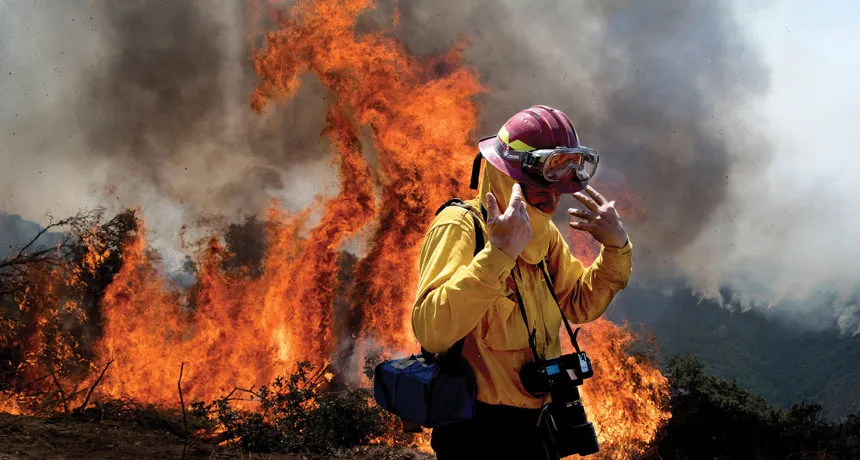
ON THE SCENE Photographer James Balog (shown here next to a California wildfire) documents how people’s lives are being affected by climate change.
© 2018 Matthew Kennedy/Earth Vision Institute
Climate change, extreme weather events and debates over climate mitigation strategies dominated the news for much of the last year. Yet climate scientists continually wrestle with how best to talk about these issues: Should discussions of climate change appeal directly to people’s emotions, whether fear or anger or even hope? Or are data-driven discussions the way to go?
There is no one answer, of course. But The Human Element, a documentary starring photographer James Balog, aims directly for the gut by putting a human face on the impacts. The movie, now streaming online, shows how human-caused climate change is intersecting with people’s lives. For instance, we see flooded homes in Florida in the wake of Hurricane Irma in 2017. Global warming probably increased Irma’s intense rainfall, researchers have found. We also see firefighters battling wildfires in the American West (the movie is almost entirely shot in the United States). “I felt a great sense of urgency to bear witness,” Balog says in the film.
That collision of people and planet is something that Balog, also the subject of the 2012 documentary Chasing Ice, has been capturing in photographs for decades. In The Human Element, his work is framed through the four ancient elements: earth, air, fire and water.
People, Balog suggests, are a fifth element — a force of nature, too. People are driving climate change, and their lives are being altered by it.
It is in showing the faces of those directly affected by our tampering with nature that the movie packs its most powerful punches. After capturing the desolation of a family standing in knee-deep water inside their home in Irma’s aftermath, the film shows other water-related impacts, particularly the plight of the residents of Tangier Island in Virginia, which is being rapidly and inexorably swallowed by the rising waters of the Chesapeake Bay.
The air segment focuses on how humans are altering the atmosphere, specifically with such pollution as volatile organic compounds emitted by planes, cars, trucks and facilities that process oil and gas. One heart-wrenching scene takes Balog to a school in Denver that specializes in treating kids with asthma, a condition often triggered by pollution. The kids are trained to treat themselves during an asthma attack; many do so several times a day.
In the fire segment, Balog photographs firefighters as they wearily but valiantly tackle the 2016 Soberanes Fire near Big Sur, Calif. With a price tag of $260 million, the blaze is among the most expensive ever battled in the United States. In the film, geographer Tania Schoennagel of the University of Colorado Boulder notes that climate change, as well as the increasing encroachment of human communities into former wilderness (SN: 12/22/18 & 1/5/19, p. 8), is already transforming the wildfire season. Since the 1970s, she says, there has been a 1,000 percent increase in the frequency of megafires — fires burning at least 40,000 hectares — in parts of the western United States.
Finally, the earth segment brings Balog to the coal-mining country of Kentucky and Pennsylvania — where, he says, “what we’ve dug from the Earth and burned has changed the other ‘elements.’ ” Balog, whose grandfather died while mining coal, paints a grim picture of how a fading industry with dwindling jobs has left former miners in dire straits. But the segment ends on a rare note of hope — and offers the film’s only nod at climate mitigation efforts. Balog follows a pair of developers who are planning to build a massive solar energy farm on reclaimed coal-mining land in hopes of bringing new jobs to the impoverished area.
The Human Element also doesn’t dwell for long on actual climate science, though the scientists who appear throughout provide helpful context for each of the movie’s segments.
What the film does do, and does well, is tell a series of human stories, accompanied by Balog’s haunting photos. The combination of stories and images is indeed an effective, powerful way to communicate the impacts of climate change.
FORCE OF NATURE Watch the trailer for The Human Element. |







